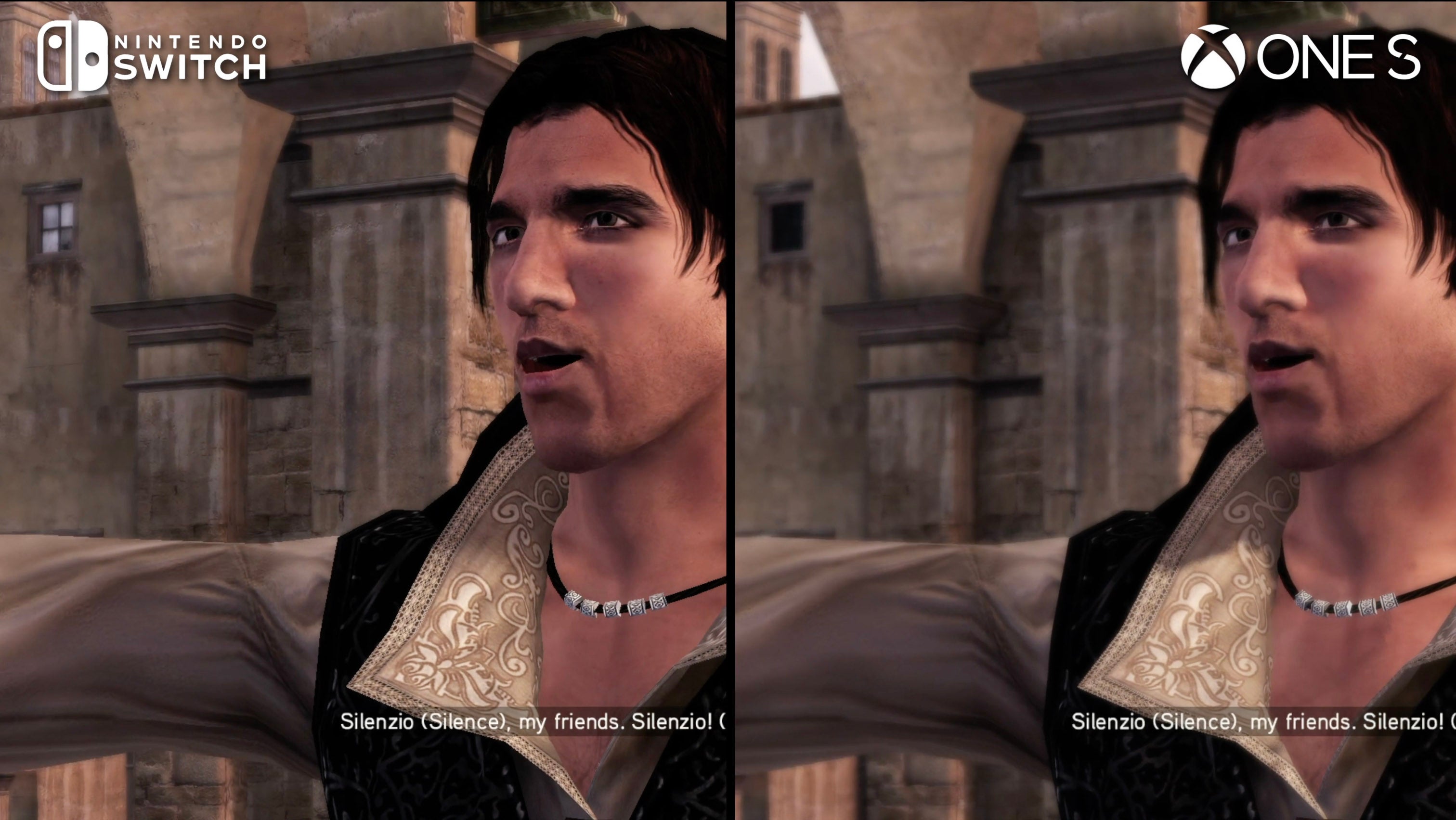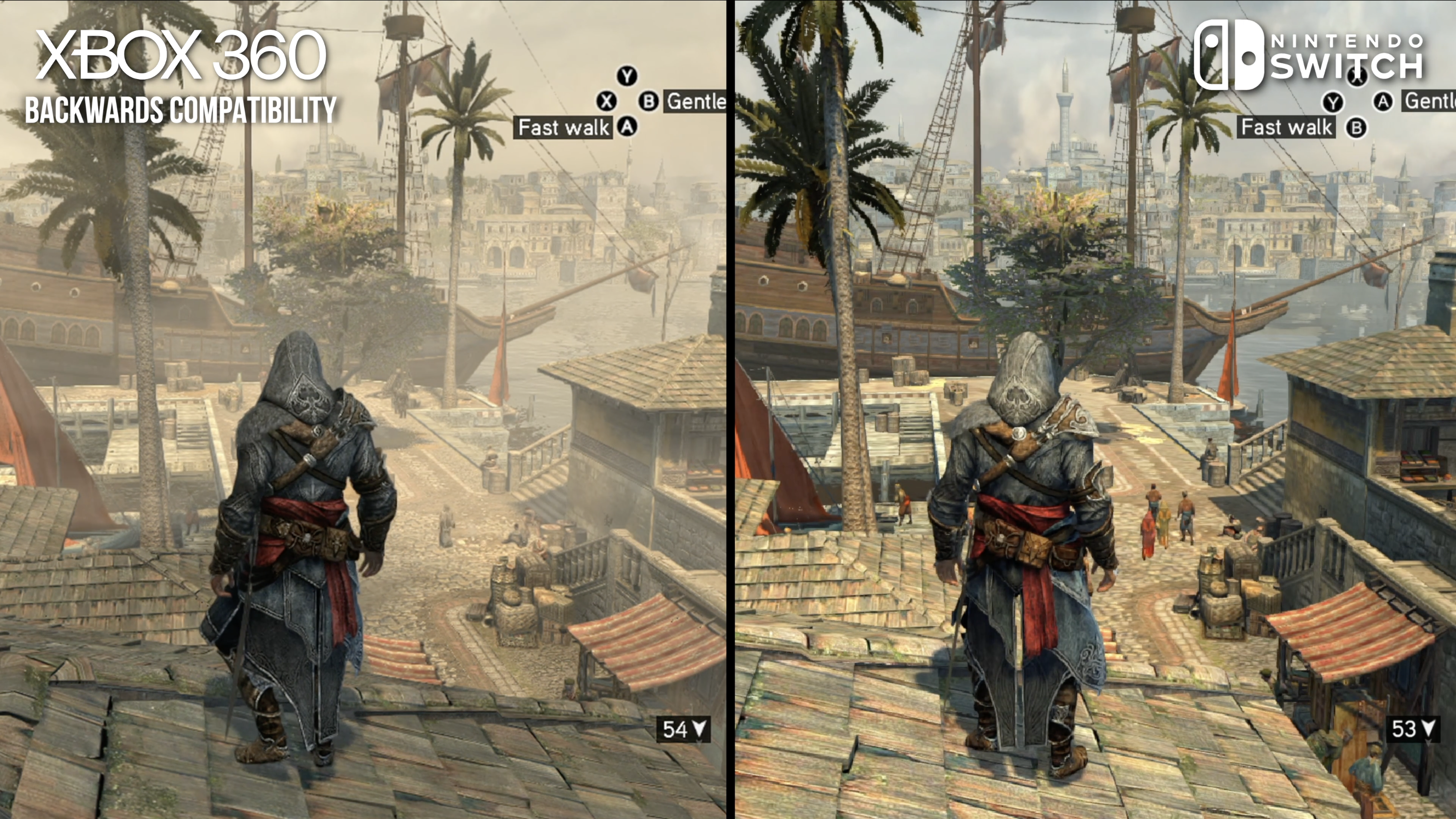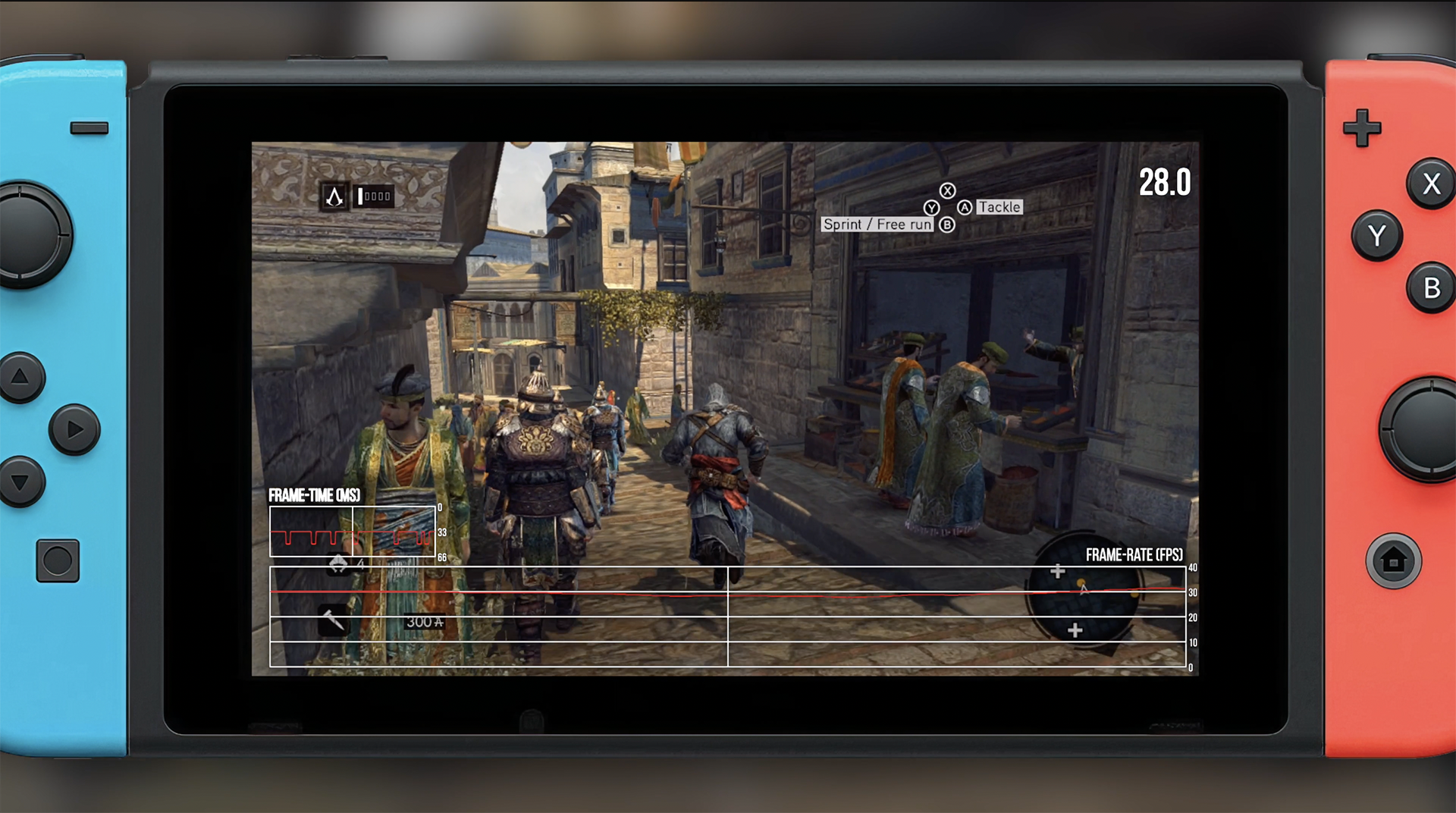In theory, these games should be a good fit for Switch. The open world action-adventure games are full of small tasks and missions suitable for short play sessions. Plus, early instalments have technical roots on the seventh generation of consoles, which the Switch has proven more than capable of matching, especially as we’re looking at earlier titles in the series. There’s a clear visual progression: Assassin’s Creed 2 is a reasonable enough looking mid-generation effort, but with clear flaws. Facial modelling and animation is awkward, and environmental detail is limited, with flat and plain looking buildings. Brotherhood shows some moderate improvements, particularly in character faces, but is otherwise similar. Revelations, on the other hand, is a mature-looking late-generation PS3/Xbox 360 game, with much more realistic lighting and geometry-rich environments. The city of Constantinople is bathed in smoke, fog, and haze, and has great weather effects, including a reasonable approximation of cloud shadows. Character rendering took another big step here, with a particularly realistic portrayal of skin for the time. It was a technical gem, only let down by poor performance on consoles - although the two prior games weren’t very stable either. So how do these games fare on Switch? Let’s start with AC2, which is a complicated and rather compromised conversion. The original release had a stylised but somewhat unrealistic look to scene lighting, stripped out of the 2016 release of the Ezio Collection in favour of a normalised colour palette, more realistic skin tones, flatter lighting with fewer highlights and pared-back bloom. The Switch version is similar to the last-gen console builds, but with some cuts: depth of field is mostly gone, ambient occlusion is cut, and shadow resolution and draw distances are also impacted. All of these changes further remove the game from the original aesthetic of the PS3/Xbox 360 release. Thankfully, Assassin’s Creed Brotherhood was left more or less untouched in the original Ezio Collection, outside of improvements to ambient occlusion and texture resolution. The settings adjustments on Switch are familiar - shadow quality and draw distance have been reduced, and ambient occlusion and depth of field are cut out entirely - but don’t sting quite as much here, as the overall aesthetic is more or less preserved from the original release. Revelations is a little more interesting. The original Ezio Collection is largely a match for the Xbox 360 version, outside of some boosts to texture resolution - and the same Switch cuts are present for this title as well. However, there is one further cut on Switch, and it’s a big one. Some of the atmospherics - like the bandwidth-heavy dust effects - are gone, giving the game a simpler and less weathered appearance. The Switch version looks clearer, brighter, and less sophisticated in many scenes. There are also some distracting shadow filtering artefacts in certain cutscenes on Switch which are most noticeable on character self-shadows. Outside of Assassin’s Creed 2, which doesn’t translate particularly well in any version of the Ezio Collection, the Switch releases hold up for the most part. Still, the removal of depth of field, ambient occlusion, and other visual effects makes these Switch releases look rather clinical at times, sometimes comparing unfavourably to the Xbox 360 versions - surprising bearing in mind the age of the original games. In terms of image quality, Switch’s docked mode offers up a 1080p resolution, which drops down as low as 936p under load. Assassin’s Creed 2 and Brotherhood very rarely deviate from 1080p, but Revelations does tend to cut resolution in some shots, particularly in long views of the city. 1080p is achieved most of the time and the image looks sharp and detailed for a Switch title. Revelations shores up the presentation with a post-process anti-aliasing technique, while AC2 and Brotherhood operate without anti-aliasing of any kind. This is a little odd, as the 2016 Ezio Collection used a post-process effect for all titles, and the original releases of Brotherhood and AC2 used 2x MSAA on Xbox 360. Portable mode employs a similar setup, although the results are a bit more variable. The resolution target is cut to 720p, with lows around 540p. Resolution takes a dive more often here, particularly in Revelations and Brotherhood. City shots are the biggest offenders in Revelations, while crowd scenes and cinematics tend to reduce resolution in the prior titles. This is complicated slightly by Ubisoft’s approach to image scaling. When Ezio Collection drops resolution, it scales the image back up without using linear filtering, and instead appears to be using nearest neighbour filtering. This tends to exaggerate the appearance of resolution drops by introducing uneven scaling artefacts, although image sharpness is better preserved. This applies to both portable and docked modes. A more conventional approach to image scaling would have been best I feel, as this tends to distract. When portable mode is operating at native res, though, these games look great on the internal Switch display. AC2 and Brotherhood stand out in particular and look super-sharp owing to their lack of anti-aliasing. Performance is mostly positive. Docked mode operates at a solid 30fps across all titles, with dips only in rare circumstances. Character close-ups in a few cutscenes in Assassin’s Creed 2 pull frame-rates briefly into the high 20s, and walking around in Constantinople in Revelations can see similar dips on occasion. Many of the dips are momentary and seem to be caused by lag in the dynamic resolution system - once resolution stabilises, frame-rates usually recover to 30fps. Portable mode fares somewhat worse. The same spots that cause performance issues in docked play still drop frames here, and some action-heavy scenes also seem to cause problems. Revelations is the worst offender here, though all of the games exhibit these issues to one degree or another. Portable play is still far more stable than the shaky 30fps of the original games on Xbox 360, but isn’t quite delivering the same consistency of the docked version. Unfortunately, there is one final oddity here, and that’s the audio mix. Both the original game and Ezio Collection had a cinematic audio mix, with loud music and explosions, and comparatively quiet dialogue, with a mix that carried all these elements with a wide dynamic range. Some of the detail seems to have been lost here, and the dialogue is much louder in the mix in some scenes. The audio compression issues present in other Assassin’s Creed games on Switch seem to have made a return here. Many scenes still sound fine, but others are noticeably degraded. The Switch port of the Ezio Collection isn’t without its faults but it’s worth taking a look at. On the minus side, there are a range of graphical changes and cutbacks - some part of the original Ezio Collection release, but most unique to the Switch versions. That said, performance and image quality are mostly good: outside of some occasional hiccups with dynamic resolution scaling, the Switch release maintains a consistent 30fps and mostly hits its resolution targets, though portable mode can be noticeably unstable at times. For those looking to enjoy Assassin’s Creed on the go, this collection should do the trick - but ultimately, the Ezio Collection falls short of earlier Switch Assassin’s Creed ports. These aren’t bad versions by any means, but they could have been better.


